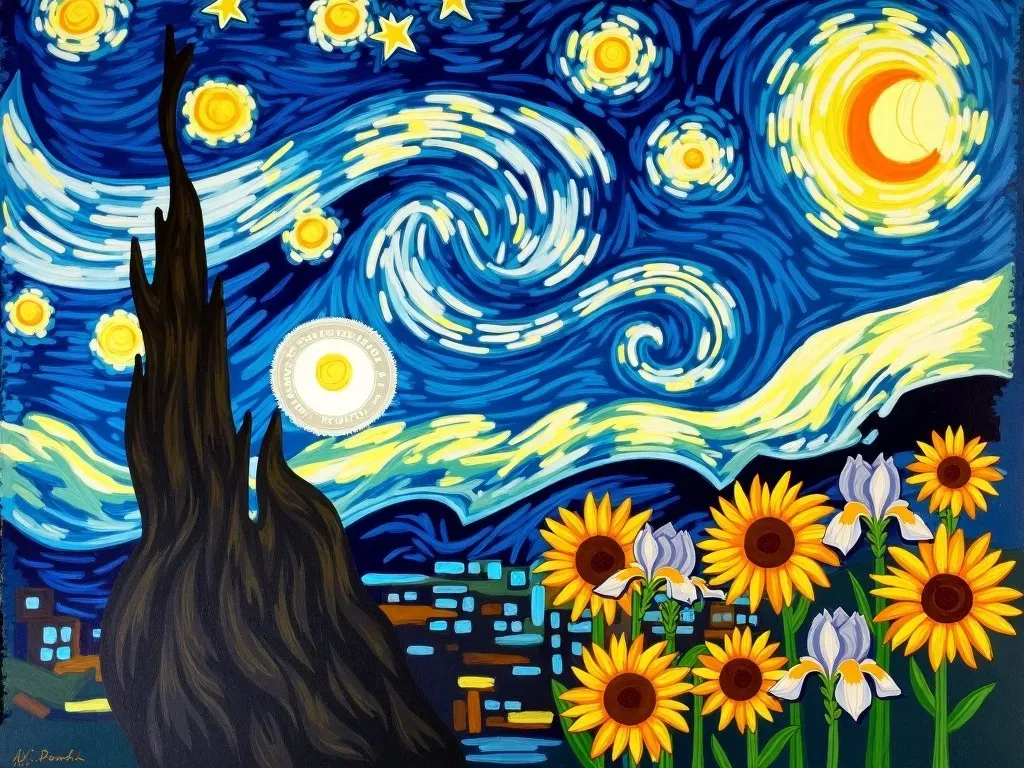Vincent Van Gogh is widely recognized for his remarkable contributions to the world of art with his famous paintings. His works encapsulate a range of emotions and experiences that reflect his tumultuous life and the struggles he faced. Van Gogh is significant among famous painters for his post-impressionist style and his groundbreaking approach to color, brushwork, and subject matter.
Van Gogh’s Artistic Journey
Vincent Willem Van Gogh (1853–1890) was a Dutch post-impressionist painter who produced around 2,100 artworks during his lifetime, encompassing approximately 860 oil paintings. Despite his struggles with mental illness and a lack of commercial success during his lifetime, he is now hailed as one of the most influential figures in Western art history. Van Gogh’s paintings are filled with vibrant colors, dynamic brush strokes, and deep emotional expression.
Iconic Paintings by Van Gogh
Each of Van Gogh’s Famous Paintings offers a glimpse into his psyche, illuminating the creative genius and tormented soul behind the canvas. Below are some of the most noteworthy pieces that have earned their place in the pantheon of iconic artworks.
| Painting | Year | Category | Notable Features |
|---|---|---|---|
| The Starry Night | 1889 | Landscape | Swirling night sky, bright stars, emotional resonance |
| Sunflowers | 1888 | Still Life | Vivid yellows, textured brushwork |
| The Bedroom | 1888 | Interior | Unconventional perspectives, bold colors |
| The Potato Eaters | 1885 | Genre Painting | Depicts peasant life, dark tones, somber atmosphere |
| Self-Portrait with Bandaged Ear | 1889 | Self-Portrait | Intense gaze, rough brush strokes, a narrative of pain |
| Irises | 1889 | Floral | Vibrant colors, delicate petals, dynamic composition |
| Café Terrace at Night | 1888 | Night Scene | Outdoor café scene, starry sky, deep blues and yellows |
| The Café Terrace at Night | 1888 | Night Scene | The interplay of light and dark creates an inviting scene |
Significance of Van Gogh’s Work
Vincent Van Gogh’s paintings are admired not just for their aesthetic qualities but also for their depth of emotion. Art historians emphasize his innovative color palette and expressive brushwork, which were revolutionary for his time. Each stroke tells a story, and his ability to convey emotion through his art has significantly impacted modern artists.
Facts & Figures About Van Gogh’s Art
Here are some interesting facts and figures to demonstrate the impact of Van Gogh’s work:
- Total Paintings: Approximately 2,100 artworks, including over 860 oil paintings.
- Most Famous Painting: "The Starry Night" has become a cultural icon and one of the most reproduced images in art history.
- Sales Stats: Art from Van Gogh consistently fetches high prices at auctions, with "Portrait of Dr. Gachet" selling for over $82 million in 1990.
- Posthumous Fame: He became popular only after his death, with retrospective exhibitions starting in the early 20th century.
Deep Dive into Top Van Gogh Masterpieces
-
The Starry Night
- Overview: Painted during his stay at an asylum, "The Starry Night" features a swirling night sky over a quiet town, expressing Van Gogh’s emotional turmoil and profound connection with the universe.
- Symbolism: The cypress tree, often associated with mourning, reaches towards the heavens, symbolizing his deep yearning for peace and understanding.
-
Sunflowers
- Overview: This series of still-life paintings showcases Van Gogh’s love for color and nature. The bright yellows represent warmth and happiness, contrasting with the artist’s internal struggles.
- Cultural Impact: "Sunflowers" became synonymous with Van Gogh and are frequently referenced in popular culture.
-
The Potato Eaters
- Overview: Created when Van Gogh was living in poverty, this painting reflects the lives of peasant workers and their intimate relationship with food and labor.
- Theme of Hardship: Unlike his later colorful works, this piece uses dark tones to convey the grim realities of rural life.
-
The Bedroom
- Overview: Capturing Van Gogh’s own room in Arles, the unique perspective and vibrant colors evoke feelings of comfort and rest.
- Psychological Insight: The mismatched furniture creates a sense of disorientation, reflecting his tumultuous mental state.
Popular Van Gogh Artworks in Modern Culture
Van Gogh’s impact on modern design and popular culture has been profound. His artworks are frequently reproduced in various forms, from fashion collections to advertising campaigns. Many of his pieces are displayed in museums and galleries worldwide, making them accessible to the masses.
| Exhibition/Event | Year | Notable Location |
|---|---|---|
| Van Gogh Museum Established | 1973 | Amsterdam, Netherlands |
| Blockbuster Exhibitions Globally | Various | London, Paris, Tokyo (multiple) |
FAQs
What are Vincent Van Gogh’s most famous paintings?
- Some of his most famous paintings include "The Starry Night," "Sunflowers," "The Bedroom," "Irises," and "The Potato Eaters."
Why is Van Gogh’s work considered so valuable?
- Van Gogh’s innovative Techniques, emotional depth, and unique style contributed to his historical significance. His works have gained immense market value, with substantial auction prices reflecting their importance.
What themes are common in Van Gogh’s works?
- Many of Van Gogh’s artworks explore themes of struggle, isolation, nature, and the human experience. His emotional turmoil often translates into vivid color schemes and expressive forms.
Where can I see Van Gogh’s artworks?
- Major collections can be found in museums such as the Van Gogh Museum in Amsterdam, the Museum of Modern Art in New York City, and the Musée d’Orsay in Paris.
For further reading on Vincent Van Gogh’s famous paintings and their extraordinary impact, visit Artland Magazine.
In conclusion, Vincent Van Gogh’s famous paintings remain a testament to his ingenuity, creativity, and the enduring power of art to capture the complex human experience. His legacy continues to inspire new generations of artists and art enthusiasts around the globe.
